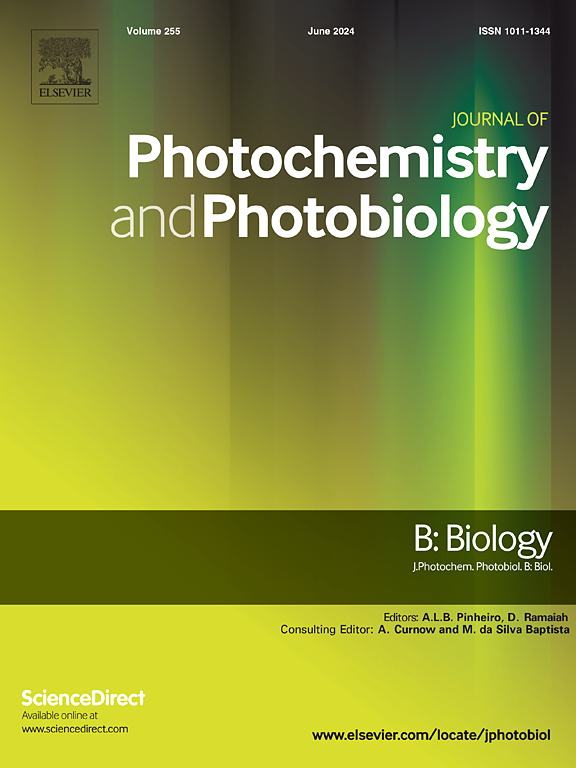低紫外线b驯化下蓝藻褐藻生长和防御策略的蛋白质组学研究。
IF 3.9
2区 生物学
Q2 BIOCHEMISTRY & MOLECULAR BIOLOGY
Journal of photochemistry and photobiology. B, Biology
Pub Date : 2025-01-12
DOI:10.1016/j.jphotobiol.2025.113101
引用次数: 0
摘要
防御优先于生长经常发生在紫外线(UV)-B辐射下,虽然一些研究表明它对光合生物有促进生长的作用,但它们如何克服生长-防御的权衡尚不清楚。本研究通过定量蛋白质组学、生理生化分析,破译了蓝藻对低UV-B辐射(0.08 W m-2)的驯化反应。我们发现了628个显著改变的蛋白,其中能量产生和转化相关蛋白占主导地位。经过uv - b驯化的细胞中,藻红蛋白和叶绿素合成相关酶的丰度显著增加,线性和循环电子传递速率增强,这进一步导致光诱导的NADPH生成(27%)和ATP含量(67%)增加。增加的光合能量供应可以促进褐藻的生长和防御。与未适应uv -b的细胞相比,经uv -b驯化的细胞的胞外碳酸酐酶活性(142%)、核酮糖-1,5-二磷酸羧化酶/加氧酶活性(87%)和pH补偿点均增加。低UV-B还诱导了核糖体的异质性,核心核糖体蛋白、RNA修饰相关酶以及核糖体生物发生和翻译相关辅助因子的丰度发生了显著变化。此外,低UV-B激活了多种防御策略,如真菌孢素样氨基酸合成、reca依赖性DNA修复途径和谷胱甘肽氧化还原系统的显著上调。我们的研究结果表明,在低UV-B驯化条件下,蓝藻Nostoc sphaeroides通过提高光合能量供应来平衡生长和防御,这为克服生长和防御权衡的机制提供了新的见解。本文章由计算机程序翻译,如有差异,请以英文原文为准。
Proteomic insight into growth and defense strategies under low ultraviolet-B acclimation in the cyanobacterium Nostoc sphaeroides
Prioritizing defense over growth often occurs under ultraviolet (UV)-B radiation while several studies showed its growth-promoting effects on photosynthetic organisms, how they overcome the growth–defense trade-off is unclear. This study deciphered the acclimation responses of the cyanobacterium Nostoc sphaeroides to low UV-B radiation (0.08 W m−2) using quantitative proteomic, physiological and biochemical analyses. We identified 628 significantly altered proteins, among which energy production and conversion related proteins dominated. The UV-B-acclimated cells exhibited a significant increase in the abundance of the phycoerythrin and chlorophyll synthesis related enzymes, along with enhanced linear and cyclic electron transport rates, which further led to a rise in light-induced NADPH generation (27 %) and ATP content (67 %). The enhanced photosynthetic energy supply could fuel both growth and defense in Nostoc sphaeroides. The UV-B-acclimated cells showed enhanced photosynthetic carbon fixation, as evidenced by an increase in extracellular carbonic anhydrase activity (142 %), ribulose-1,5-bisphosphate carboxylase/oxygenase activity (87 %) and the pH compensation point, compared to non-UV-B-acclimated cells. Low UV-B also induced ribosome heterogeneity, as indicated by significant changes in the abundance of core ribosomal proteins, RNA modification related enzymes, and ribosome biogenesis and translation related accessory factors. Additionally, low UV-B activated multiple defense strategies, such as significant upregulation of mycosporine-like amino acid synthesis, RecA-dependent DNA repair pathways and the glutathione redox system. Our findings suggested that growth and defense were balanced by enhancing the photosynthetic energy supply under low UV-B acclimation in the cyanobacterium Nostoc sphaeroides, which provides novel insight into mechanisms for overcoming growth–defense trade-offs.
求助全文
通过发布文献求助,成功后即可免费获取论文全文。
去求助
来源期刊
CiteScore
12.10
自引率
1.90%
发文量
161
审稿时长
37 days
期刊介绍:
The Journal of Photochemistry and Photobiology B: Biology provides a forum for the publication of papers relating to the various aspects of photobiology, as well as a means for communication in this multidisciplinary field.
The scope includes:
- Bioluminescence
- Chronobiology
- DNA repair
- Environmental photobiology
- Nanotechnology in photobiology
- Photocarcinogenesis
- Photochemistry of biomolecules
- Photodynamic therapy
- Photomedicine
- Photomorphogenesis
- Photomovement
- Photoreception
- Photosensitization
- Photosynthesis
- Phototechnology
- Spectroscopy of biological systems
- UV and visible radiation effects and vision.

 求助内容:
求助内容: 应助结果提醒方式:
应助结果提醒方式:


